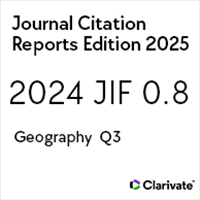Habitar entre fronteras. Un estudio teórico sobre mujeres migrantes y hogares transnacionales y transfronterizos
To inhabit across borders. A theoretical study on migrant women and transnational and cross-border homes
https://doi.org/10.21670/ref.2102065
Palabras clave:
migración, género, frontera, hogar, análisis teóricoResumen
El artículo interroga cómo las mujeres migrantes internacionales desarrollan experiencias de construir hogares a través de espacialidades simultáneas. Se realiza un análisis teórico de los usos del concepto de hogar en los estudios migratorios y de frontera desde la última década del siglo XX, con un enfoque específico en las dimensiones transnacionales y transfronterizas del fenómeno. Se indaga en las particularidades de los hogares transfronterizos, y se asume que las investigaciones realizadas en territorios limítrofes verificaron una intensificación de las desigualdades vividas por las mujeres en estos espacios. Al seguir los debates heideggerianos se plantea que las desigualdades vividas por las mujeres migrantes y transfronterizas se materializan en sus corporalidades y en sus experiencias de habitar, lo que tiene implicaciones multidimensionales en la manera como ellas articulan sus hogares. Se proponen reflexiones finales sobre la migración, las mujeres y la producción de hogares a través de las fronteras.Abstract This paper interrogates how international migrant women develop experiences of homemaking across simultaneous spatialities. Is conducted a theoretical analysis of the uses of the concept of home in migration and border studies since the last decade of the twentieth century, with a specific focus on the transnational and cross-border dimensions of the phenomenon. It explores the particularities of cross-border homes, assuming that the research carried out in border territories has revealed an intensification of the inequalities experienced by women in these areas. Following the Heideggerian debates it is proposed that the inequalities experienced by migrant and cross-border women are materialized in their bodies and in their experiences of inhabiting, which has multidimensional implications in the way they articulate their homes. Final reflections on migration, women and the homemaking across borders are proposed.
Citas
Acosta, E. (2015). Cuidados en crisis. Mujeres migrantes hacia España y Chile. Universidad de Deusto.
Ahmed, S. (1999). Home and away. Narratives of migration and estrangement. International Journey of Cultural Studies, 2(3), 329-347. https://doi.org/10.1177/136787799900200303 DOI: https://doi.org/10.1177/136787799900200303
Ahmed, S., Castañeda, C., Fortier, A. & Sheller, M. (Eds.). (2003). Uprootings/Regroundings. Questions of Home and Migration. Berg.
Alegría, T. (2002). Demand and supply of Mexican cross-border workers. Journal of Borderlands Studies, 17(1), 37-55. https://doi.org/10.1080/08865655.2002.9695581 DOI: https://doi.org/10.1080/08865655.2002.9695581
Assis, G. O. (2004). De Criciúma para o mundo: rearranjos familiares e de gênero nas vivências dos novos migrantes brasileiros [Tesis doctoral]. Universidad Estadual de Campinas. http://repositorio.unicamp.br/jspui/handle/REPOSIP/280714
Assis, G. O. (2007). Mulheres migrantes no passado e no presente: gênero, redes sociais e migração internacional. Revista de Estudos Feministas, 15(3), 745-772. https://doi.org/10.1590/S0104-026X2007000300015 DOI: https://doi.org/10.1590/S0104-026X2007000300015
Assis, G. O. (2011). Entre dois lugares: as experiências afetivas de mulheres imigrantes brasileiras nos Estados Unidos. En A. Piscitelli, G. O. Assis & J. M. Olivar (Coords.), Gênero, sexo, amor e dinheiro: mobilidades transnacionais envolvendo o Brasil (pp. 321-362). UNICAMP/PAGU.
Assis, G. O. (2014). Entrelugares e movilidades. En G. O. Assis, L. Simões & S. Bórneo (Coords.), Entrelugares e mobilidades. Desafios feministas (pp. 11-34). Copiart.
Bachelard, G. (1964). The poetics of space. Orion Press.
Balbo, L., Bianchi, M., Zanuso, L. & Wilson, E. (1978). Doppia presenza e mercato del lavoro femminile. Inchiesta, (32). https://www.edizionidedalo.it/inchiesta/inchiesta-32-1978.html
Baxter, R. & Brickell, K. (2014). For home unmaking. Home Cultures, 11(2), 133-143. https://doi.org/10.2752/175174214X13891916944553 DOI: https://doi.org/10.2752/175174214X13891916944553
Bettio, F., Simonazzi, A. M. & Villa, P. (2006). Change in care regimes and female migration, the “care drain” in the Mediterranean. Journal of European Social Policy, 16(3), 271-285. https://doi.org/10.1177/0958928706065598 DOI: https://doi.org/10.1177/0958928706065598
Blunt, A. & Dowling, R. (2006). Home. Routledge. DOI: https://doi.org/10.4324/9780203401354
Bonhomme, M. (2013). Cultura material y migrantes peruanos en Chile: un proceso de integración desde el hogar. Polis Revista Latinoamericana, 12(35), 6-84. http://dx.doi.org/10.4067/S0718-65682013000200004 DOI: https://doi.org/10.4067/S0718-65682013000200004
Bosco, F. J., Aitken, S. C. & Herman, T. (2011). Women and children in a neighborhood advocacy group: engaging community and refashioning citizenship at the United States-Mexico border. Gender, Place & Culture, 18(2), 155-178. https://doi.org/10.1080/0966369X.2010.551652 DOI: https://doi.org/10.1080/0966369X.2010.551652
Brickell, K. (2012). Geopolitics of home. Geography Compass, 6(10), 225-244. https://doi.org/10.1111/j.1749-8198.2012.00511.x DOI: https://doi.org/10.1111/j.1749-8198.2012.00511.x
Camacho, G. (2010). Mujeres migrantes: trayectoria laboral y perspectiva de desarrollo humano. Clacso. http://biblioteca.clacso.edu.ar/clacso/becas/20120418042041/mujeres.pdf
Chardon, A. (2010). Reasentar un hábitat vulnerable. Teoría versus praxis. Revista Invi, 25(70), 17-75. http://dx.doi.org/10.4067/S0718-83582010000300002 DOI: https://doi.org/10.4067/S0718-83582010000300002
Chiu, T. Y. (2019). Everyday mixed status: spillover effects of state power in Mainland China-Hong Kong cross-border families. Gender, Place & Culture, 27(5), 1-17. https://doi.org/10.1080/0966369X.2019.1615411 DOI: https://doi.org/10.1080/0966369X.2019.1615411
Datta, K., Mcllwaine, C., Evans, Y., Herbert, J., May, J. & Wills, J. (2010). A migrant ethic of care? Negotiating care and caring among migrant workers in London's low-pay economy. Feminist Review, 94(1), 93-116. https://doi.org/10.1057/fr.2009.54 DOI: https://doi.org/10.1057/fr.2009.54
Davis, A. (2016). Mulheres, Raça e Classe. Boitempo.
De Oliveira, O. & García, B. (1984). Migración a grandes ciudades del Tercer Mundo: algunas implicaciones sociodemográficas. Estudios Sociológicos, 2(4), 71-103. https://www.jstor.org/stable/40420902
Diatlova, A. (2017). Conceptualisation of home among Russian-speaking women engaged in commercial sex in Finland. Gender, Place & Culture, 25(1), 61-79. https://doi.org/10.1080/0966369X.2017.1400950 DOI: https://doi.org/10.1080/0966369X.2017.1400950
Domenech, E. & Pereira, A. (2017). Estudios migratorios e investigación académica sobre las políticas de migraciones internacionales en Argentina. Íconos, Revista de Ciencias Sociales, (58), 83-108. https://doi.org/10.17141/iconos.58.2017.2487 DOI: https://doi.org/10.17141/iconos.58.2017.2487
Easthope, H. (2004). A place called home. Housing, Theory and Society, 21(3), 128-138. https://doi.org/10.1080/14036090410021360 DOI: https://doi.org/10.1080/14036090410021360
Fisher, B. & Tronto, J. (1990). Toward a feminist theory of caring. En E. Abel & M. Nelson (Coords.), Circles of care: work and identity in womens' lives (pp. 36-54). State University of New York Press.
Garduño, E. (2003). Antropología de la frontera, la migración y los procesos transnacionales. Frontera Norte, 15(30). http://dx.doi.org/10.17428/rfn.v15i30.1511
Gilligan, C. (1982). In a different voice: psychological theory and women’s development. Harvard University Press.
Glick-Schiller, N. (1999). Transmigrants and Nation-States: something old and something new in the U. S. immigrant experience. En C. Hirschman, J. DeWind & P. Kasinitz (Coords.), Handbook of international migration: the American experience (pp. 94-119). Russell Sage.
Gonzálvez, H. (2013). Los cuidados en el centro de la migración. La organización social de los cuidados transnacionales desde un enfoque de género. Revista Migraciones, (33), 127-153. https://revistas.comillas.edu/index.php/revistamigraciones/article/view/1024
Gregorio Gil, C. (2009). Silvia, ¿quizá tenemos que dejar de hablar de género y migraciones? Transitando por el campo de los estudios migratorios. Gazeta de Antropología, 25(1), 1-19. http://www.ugr.es/~pwlac/G25_17Carmen_Gregorio_Gil.html DOI: https://doi.org/10.30827/Digibug.6863
Gregorio Gil, C. & Gonzálvez, H. (2012). Las articulaciones entre género y parentesco en el contexto migratorio: más allá de la maternidad transnacional. Ankulegi, Revista de antropología social, (16), 43-58. https://aldizkaria.ankulegi.org/index.php/ankulegi/article/view/50/146
Gregorio Gil, C. & Ramírez, A. (2000). ¿En España es diferente..? Mujeres inmigrantes dominicanas y marroquíes. Papers. Revista de Sociología, 60, 257-273. https://papers.uab.cat/article/view/v60-gregorio-ramirez-fernandez/pdf-es DOI: https://doi.org/10.5565/rev/papers/v60n0.1042
Grimson, A. (2005). Fronteras, Estados e identificaciones en el cono sur. En D. Mato (Coord.), Cultura, política y sociedad. Perspectivas latinoamericanas (pp. 1-10). Clacso.
Guizardi, M. (2019). Habitar la interseccionalidad. Fricciones identitarias y violencias de género en las fronteras nacionales. En A. Vera, I. Aguilera & R. Fernández (Coords.), Nación, otredad, deseo. Producción de la diferencia en tiempos multiculturales (pp. 141-182). Ediciones Universidad Academia de Humanismo Cristiano.
Guizardi, M., González, H. & Stefoni, C. (2018). De feminismos y movilidades. Debates críticos sobre migraciones y género en América Latina (1980-2018). Rumbos TS, (18), 37-66. http://revistafacso.ucentral.cl/index.php/rumbos/article/view/6
Guizardi, M., López, E, Nazal, E. & Valdebenito, F. (2017). Fronteras, género y patriarcado. Discusiones teóricas para replantear el transnacionalismo migrante. Límite. Revista Interdisciplinaria de Filosofía y Psicología, 12(38), 22-38. https://www.revistalimite.cl/index.php/limite/article/view/69
Guizardi, M., Valdebenito, F., López, E. & Nazal, E. (2018). ¿Transnacionales o transfronterizas? Repensando las experiencias migratorias familiares en zonas de frontera. En H. Gonzálvez & J. Cienfuegos (Coords.), Familias transnacionales. Un campo en construcción en Chile (pp. 147-182). Crann editores.
Haesbaert, R. (2013). Del mito de la desterritorialización a la multiterritorialidad. Cultura y Representaciones Sociales, 8(15), 9-42. http://www.culturayrs.unam.mx/index.php/CRS/article/view/401
Heidegger, M. (1954). Construir, habitar, pensar. En M. Heidegger (Coord.), Conferencias y Ensayos (pp. 150-163). G. Neske.
Herrera, G. (2012). Género y migración internacional en la experiencia latinoamericana. De la visibilización del campo a una presencia selectiva. Revista Política y Sociedad, 49(1), 35-46. https://doi.org/10.5209/rev_POSO.2012.v49.n1.36518 DOI: https://doi.org/10.5209/rev_POSO.2012.v49.n1.36518
Herrera, G. & Sørensen, N. N. (2017). Presentación del dossier. Migraciones internacionales en América Latina: miradas críticas a la producción de un campo de conocimientos. Revista Íconos, (58), 11-36. https://revistas.flacsoandes.edu.ec/iconos/article/view/2695 DOI: https://doi.org/10.17141/iconos.58.2017.2695
Herrera Lima, F. F. & Pries, L. (2006). Trabajo, migraciones y producción sociológica reciente en América Latina. Un panorama no exhaustivo. En E. de la Garza Toledo (Coord.), Tratado latinoamericano de sociología del trabajo (pp. 523-558). Antropos/Universidad Autónoma Metropolitana-Iztapalapa.
Hochschild, A. (2001). The nanny chain. The American Prospect. https://prospect.org/features/nanny-chain/
Hochschild, A. (2002). Las cadenas mundiales de afecto y asistencia y la plusvalía emocional. En W. Hutton & A. Giddens (Coords.), En el límite. La vida en el capitalismo global (pp. 187-208). Tusquets.
Hondagneu-Sotelo, P. (2000). Feminism and migration. The Annals of the American Academy of Political and Social Science, 571(1), 107-120. https://doi.org/10.1177/000271620057100108 DOI: https://doi.org/10.1177/0002716200571001008
Hondagneu-Sotelo, P. (2001). Domestica. Inmigrant workers cleaning and caring in the shadows of affluence. University of California Press.
Laslett, B. & Brenner, J. (1989). Gender and social reproduction: historical perspectives. Annual Review of Sociology, 15, 381-404. https://www.jstor.org/stable/2083231 DOI: https://doi.org/10.1146/annurev.so.15.080189.002121
Levitt, P. (1998). Social remittances: migration driven local-level forms of cultural diffusion. The International Migration Review, 32(4), 926-948. https://doi.org/10.2307/2547666 DOI: https://doi.org/10.1177/019791839803200404
Levitt, P. & Glick-Schiller, N. (2004). Conceptualizing simultaneity: a transnational social field perspective on society. International Migration Review, 38(3), 60-91. https://www.jstor.org/stable/27645424 DOI: https://doi.org/10.1111/j.1747-7379.2004.tb00227.x
López, S. (2020). Cuidado a través de la frontera: trayectorias transfronterizas de cuidados en la región Tijuana-San Diego. Estudios Fronterizos, 21, 1-21. https://doi.org/10.21670/ref.2002044 DOI: https://doi.org/10.21670/ref.2002044
Martínez-Pizarro, J. (2003). El mapa migratorio de América Latina y El Caribe, las mujeres y el género. UN/Celade/Cepal. https://repositorio.cepal.org/bitstream/handle/11362/7182/S039639_es.pdf?sequence=1&isAllowed=y
Martínez-Pizarro, J. & Orrego, C. (2016). Nuevas tendencias y dinámicas migratorias en América Latina y el Caribe. UN/Cepal/OIM. https://repositorio.cepal.org/bitstream/handle/11362/39994/S1600176_es.pdf?sequence=1&isAllowed=y
Massey, D. (1991). A global sense of place. Marxism Today, 24-29. http://banmarchive.org.uk/collections/mt/pdf/91_06_24.pdf
Miller, D. (2001). Behind closed doors. En D. Miller (Coord.), Home possessions: material culture behind closed doors (pp. 1-19). Berg. DOI: https://doi.org/10.4324/9781003085607-1
Miller, D. (2006). Things that bright up the place. Home Cultures, 3(3), 235-249. https://doi.org/10.2752/174063106779090712 DOI: https://doi.org/10.2752/174063106779090712
Milligan, C. & Wiles, J. (2010). Landscapes of care. Progress in Human Geography, 34(6), 736-754. https://doi.org/10.1177/0309132510364556 DOI: https://doi.org/10.1177/0309132510364556
Mills, M. B. (2003). Gender and inequality in the global labor force. Annual Review of Anthropology, 32, 41-62. https://doi.org/10.1146/annurev.anthro.32.061002.093107 DOI: https://doi.org/10.1146/annurev.anthro.32.061002.093107
Moore, J. (2000). Placing home in context. Journal of Environmental Psychology, 20(3), 207-217. https://doi.org/10.1006/jevp.2000.0178 DOI: https://doi.org/10.1006/jevp.2000.0178
Mora, C. (2008). Globalización, género y migraciones. Polis Revista Latinoamericana, (20), 1-12. https://journals.openedition.org/polis/3544 DOI: https://doi.org/10.4067/S0718-65682008000100015
Morley, D. (2001). Belongings: place, space and identity in a mediated world. European Journal of Cultural Studies, 4(4), 425-448. https://doi.org/10.1177/136754940100400404 DOI: https://doi.org/10.1177/136754940100400404
Muñoz Bravo, T. & Mendoza, X. (2018). La feminización de las migraciones internacionales. De lo global a lo local: el caso de mujeres guerrerenses en Texas. Revista de Relaciones Internacionales de la UNAM, (131), 153-177. http://www.revistas.unam.mx/index.php/rri/article/view/65921
Organización Internacional de la Migración (OIM). (2020). Informe sobre las migraciones en el mundo 2020. https://publications.iom.int/books/informe-sobre-las-migraciones-en-el-mundo-2020
Parella, S. (2003). La inserción laboral de la mujer inmigrante en los servicios de proximidad en Cataluña. Revista Internacional de Sociología, (36), 85-113. https://doi.org/10.3989/ris.2003.i36.315 DOI: https://doi.org/10.3989/ris.2003.i36.315
Parella, S. (2007). Los vínculos afectivos y de cuidado en las familias transnacionales. Migrantes ecuatorianos y peruanos en España. Migraciones Internacionales, 4(2), 151-188. http://www.scielo.org.mx/scielo.php?script=sci_arttext&pid=S1665-89062007000200006
Pinto de Carvalho, L. & Cornejo, M. (2018). Por una aproximación crítica al apego al lugar: una revisión en contextos de vulneración del derecho a una vivienda adecuada. Athenea Digital, 18(3), 1-39. https://doi.org/10.5565/rev/athenea.2004 DOI: https://doi.org/10.5565/rev/athenea.2004
Piscitelli, A. (2008). Sexo tropical em um país europeu: migração de brasileiras para a Itália no marco do “turismo sexual” internacional. Revista Estudos Feministas, 15(3), 717-744. https://doi.org/10.1590/S0104-026X2007000300014 DOI: https://doi.org/10.1590/S0104-026X2007000300014
Piscitelli, A. (2012). Migración, género y sexualidad. Brasileñas en los mercados del sexo y del casamiento en España. Mora, 18(2), 97-116. http://revistascientificas.filo.uba.ar/index.php/mora/article/view/329
Piscitelli, A. (2013). Trânsitos: brasileiras nos mercados transnacionais do sexo. Ed. da UERJ/Clam.
Piscitelli, A., de Oliveira Assis, G. O. & Nieto Olivar, J. M. (2011). Gênero, sexo, amor e dinheiro: mobilidades transnacionais envolvendo o Brasil. Unicamp/PAGU.
Portes, A. & Jensen, L. (1989). The enclave and the entrants: patterns of ethnic enterprise in Miami before and after Mariel. American Sociological Review, 54(6), 929-949. https://doi.org/10.2307/2095716 DOI: https://doi.org/10.2307/2095716
Renoldi, B. (2013). Fronteras que caminan: relaciones de movilidad en un límite trinacional. Revista Transporte y Territorio, (9), 123-140. http://revistascientificas.filo.uba.ar/index.php/rtt/article/view/307
Renoldi, B. (2015). Estados posibles: travesías, ilegalismos y controles en la Triple Frontera. Etnográfica, 19(3), 417-440. https://doi.org/10.4000/etnografica.4049 DOI: https://doi.org/10.4000/etnografica.4049
Rose, G. (1997). Situating knowledges: positionality, reflexivities and other tactics. Progress in Human Geography, 21(3), 305-320. https://doi.org/10.1191/030913297673302122 DOI: https://doi.org/10.1191/030913297673302122
Salazar Parreñas, R. (2001). Servants of globalization: women, migration and domestic work. Stanford University Press.
Sassen, S. (2001). The excesses of globalisation and the feminisation of survival. Parallax, 7(1), 100-110. https://doi.org/10.1080/13534640010015980 DOI: https://doi.org/10.1080/13534640010015980
Sassen, S. (2003). Contrageografías de la globalización. Género y ciudadanía en los circuitos transfronterizos. Traficantes de Sueños.
Segato, R. (2003). Las estructuras elementales de la violencia. Ensayos sobre género entre la antropología, el psicoanálisis y los derechos humanos. Universidad Nacional de Quilmes.
Silvey, R. (2006). Geographies of gender and migration: spatializing social difference. International Migration Review, 40(1), 64-81. https://doi.org/10.1111/j.1747-7379.2006.00003.x DOI: https://doi.org/10.1111/j.1747-7379.2006.00003.x
Sørensen, N. (2008). La familia transnacional de latinoamericanos/as en Europa. En G. Herrera & J. Ramírez (Coords.), América Latina migrante: Estado, familias, identidades (pp. 259-280). Flacso-Ecuador.
Sørensen, N. & Vammen, I. (2016). ¿A quién le importa? Las familias transnacionales en los debates sobre la migración y el desarrollo. Investigaciones Feministas, 7(1), 191-220. https://doi.org/10.5209/rev_INFE.2016.v7.n1.52707 DOI: https://doi.org/10.5209/rev_INFE.2016.v7.n1.52707
Stefoni, C. (2009). Migración, género y servicio doméstico. Mujeres peruanas en Chile. En M. E. Valenzuela & C. Mora (Eds.), Trabajo doméstico: un largo camino hacia el trabajo decente (pp. 191-232). OIT.
Tapia, M. & Ramos, R. (2013). Mujeres migrantes fronterizas en Tarapacá a principios del siglo XXI. El cruce de las fronteras y las redes de apoyo. Polis. Revista Latinoamericana, 12(35). http://dx.doi.org/10.4067/S0718-65682013000200011 DOI: https://doi.org/10.4067/S0718-65682013000200011
Tijoux, M. E. (2007). Peruanas inmigrantes en Santiago. Un arte cotidiano de la lucha por la vida. Polis Revista Latinoamericana, (18). https://journals.openedition.org/polis/4185
Tuan, Y. F. (1971). Geography, phenomenology, and the study of human nature. Canadian Geographer, 15(3), 181-192. https://doi.org/10.1111/j.1541-0064.1971.tb00156.x DOI: https://doi.org/10.1111/j.1541-0064.1971.tb00156.x
Vargas, E. D., Rodríguez, O. & Rodríguez, M. T. (2019). Hogares guatemaltecos y etnicidad en el sur de México: perfiles demográficos y socioeconómicos. Estudios Fronterizos, 20, 1-25. https://doi.org/10.21670/ref.1915036 DOI: https://doi.org/10.21670/ref.1915036
Viveros, M. (2016). La interseccionalidad. Una aproximación situada a la dominación. Debate feminista, 52, 1-17. https://doi.org/10.1016/j.df.2016.09.005 DOI: https://doi.org/10.1016/j.df.2016.09.005
Walsh, K. (2006). British expatriate belongings: mobile homes and transnational homing. Home Cultures, 3(2), 123-144. https://www.tandfonline.com/doi/abs/10.2752/174063106778053183 DOI: https://doi.org/10.2752/174063106778053183
Wilkins, A. (2017). Gender, migration and intimate geopolitics: shifting senses of home among women on the Myanmar-Thailand border. Gender, Place & Culture, 24(11), 1-20. https://doi.org/10.1080/0966369X.2017.1380608 DOI: https://doi.org/10.1080/0966369X.2017.1380608
Wimmer, A., & Glick-Schiller, N. (2002). Methodological nationalism and beyond: nation-state building, migration and the social sciences. Global networks, 2(4), 301-334. https://doi.org/10.1111/1471-0374.00043 DOI: https://doi.org/10.1111/1471-0374.00043
Wimmer, A. & Glick-Schiller, N. (2003). Methodological nationalism, the social sciences, and the study of migration: An essay in historical epistemology. International Migration Review, 37(3), 576-610. https://doi.org/10.1111/j.1747-7379.2003.tb00151.x DOI: https://doi.org/10.1111/j.1747-7379.2003.tb00151.x
Yeates, N. (2012). Global care chains: a state‐of‐the‐art review and future directions in care transnationalization research. Global Networks, 12(2), 135-154. https://doi.org/10.1111/j.1471-0374.2012.00344.x DOI: https://doi.org/10.1111/j.1471-0374.2012.00344.x
Yeoh, B. & Ramdas, K. (2014). Gender, migration, mobility and transnationalism. Gender, Place and Culture, 21(10), 1197-1213. https://doi.org/10.1080/0966369X.2014.969686 DOI: https://doi.org/10.1080/0966369X.2014.969686
































